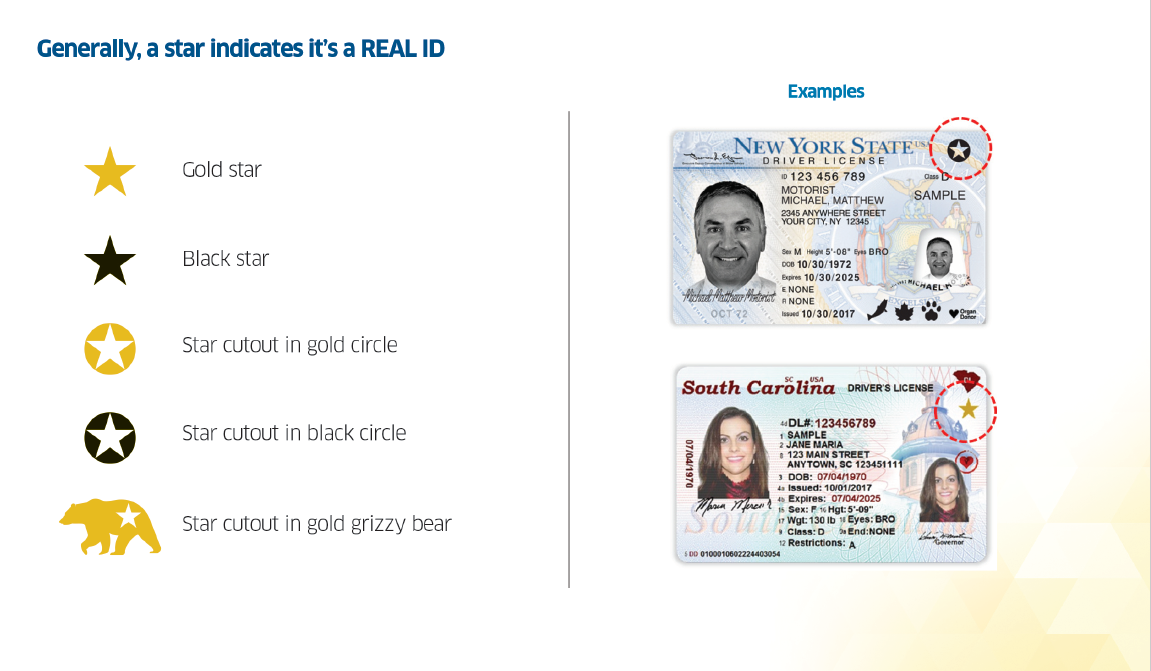
In less than a month, Americans and permanent residents will only be able to pass through airport security or enter a federal government building if they have a Real ID. Most states are not yet fully compliant, though they’ve had 18 years to prepare for this deadline.
A CBS News data analysis conducted from April 7-18 found that at least 16 states are less than 50% compliant with the law, which goes into effect May 7. The Transportation Security Administration currently plans to treat that date as an “all hands on deck” day because of the looming potential for disruptions at airport checkpoints. The chart below the article lists the states and their compliance so far with the Real ID requirement.
Department of Homeland Security
The Real ID is an enhanced ID card issued by state drivers license agencies. To obtain one, people are required to show a valid ID, as well as proof of identity, such as a passport or certified birth certificate, proof of a Social Security number and date of birth, plus two documents showing state residency, including a utility bill, credit card statement or rental agreement.
So far, 28 states are less than 70% compliant. That means that in more than half the country, as many as three in every 10 travelers may not be able to pass through an airport checkpoint in just a few weeks.
As of last week, New Jersey had the lowest compliance rate in the nation — just 17% of its state-issued IDs are Real IDs. Pennsylvania reported 26%, while Washington and Maine tell CBS News they are at 27% compliance. New York reports 43% compliance, and California has reached nearly 55% compliance.
CBS News recently traveled to a Real ID Super Center in Chicago with a line extending out the door. In Illinois, two out of three residents lack a Real ID, which prompted the state to open the downtown location in an old Walgreens, aiming to process up to 1,500 new IDs a day as it tries to catch up with surging demand. States mail the new IDs, however, so it can take up to two weeks to receive the new credential (a temporary paper license will not be considered a Real ID).
Thirteen states reported compliance rates above 90%, with seven states — Colorado, Florida, Georgia, Maryland, Nebraska, South Dakota, Wyoming and the District of Columbia — saying they’re virtually 100% compliant. Texas reports 98% compliance, Mississippi 97%, Hawaii 96%, Utah 96% and Vermont 92%.
TSA says it’s seeing about 81% compliance at airport checkpoints — meaning passengers are showing up with either a Real ID-compliant driver’s license or state ID, a passport, a valid military ID, an “enhanced” ID issued by a handful of states or other valid identification.
Earlier this month, TSA told CBS News that on May 7, when travellers show up at a TSA checkpoint with a non-compliant legacy ID, they will be subject to additional screening. TSA officers will utilize a secondary identity verification process, similar to the one used when someone’s ID is stolen or lost while traveling, to verify identity. But this can be a time-consuming process, so legacy ID holders should plan to be at the airport at least three hours before departure, instead of the usual two hours for a domestic flight. If the secondary identification verification fails, the traveler will not be allowed to enter the security checkpoint or the gate area. The agency had previously indicated there would be a phased enforcement policy.
“People will experience travel delays,” TSA spokesperson Patricia Mancha told CBS News in a recent interview at Phoenix Sky Harbor Airport. “People have had years to really plan for this, so TSA will simply enforce the laws and the rules as they apply.”
Photo by KDKA
The Real ID law was passed in 2005, in the wake of the 9/11 attacks, to try to make state-issued identification more secure and harder to counterfeit. The deadline for implementation has been delayed several times, most recently because of the pandemic. Several fully compliant states began issuing Real IDs as far back as 2009, enabling all residents to obtain a compliant ID when they renewed an existing license.
“Any new issuance of driver’s license, you had to prove your identity and lawful presence back in 2009,” said Electra Bustle, the senior director of the Colorado Division of Motor Vehicles. She says the deadline delays helped the Centennial State to be ready for the May 7 deadline. “We have a 10-year renewal cycle before you have to get a new photograph. You can see that moving it allowed us to ensure that we’re at 100% of those who are eligible to be now — to have Real IDS.”
A Real ID can be identified by a black or gold star in the upper right corner of the ID. Sometimes the star appears in a circle, while California puts its star symbol inside a golden bear.
Not everyone needs a Real ID. If you don’t fly or enter federal government buildings, a legacy ID will continue to be valid until its expiration date.
Louisiana and Tennessee did not respond to CBS News’ inquiries. Indiana requested CBS News submit a Freedom of Information Act request for the information. Based on local media reports, Louisiana is at around 30% compliance and Tennessee at nearly 47%.
States continue to process Real ID applications, so compliance numbers will continue to change, and CBS News will update these figures before the May 7 deadline.
Taylor Johnston, Sarah Ploss, Kathryn Krupnik contributed to this report.
